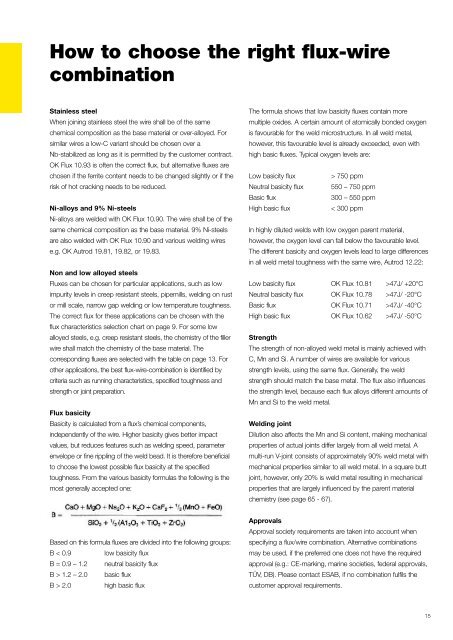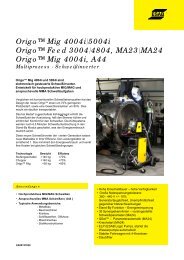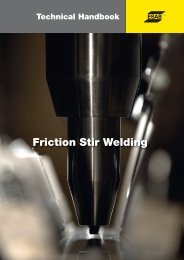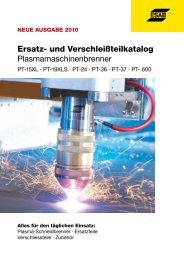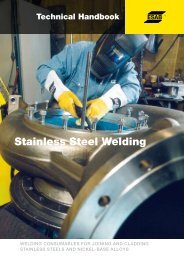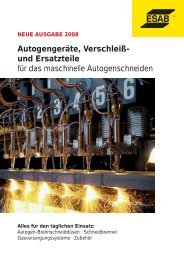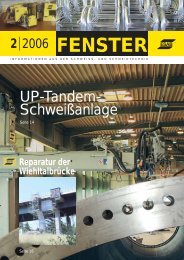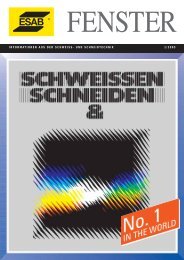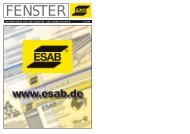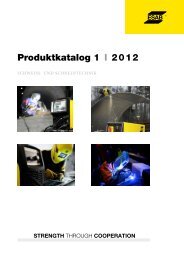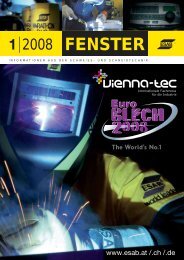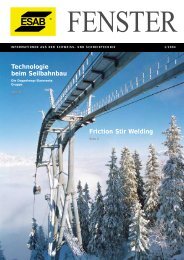Submerged Arc Welding Technical Handbook - Esab
Submerged Arc Welding Technical Handbook - Esab
Submerged Arc Welding Technical Handbook - Esab
Create successful ePaper yourself
Turn your PDF publications into a flip-book with our unique Google optimized e-Paper software.
How to choose the right flux-wire<br />
combination<br />
Stainless steel<br />
When joining stainless steel the wire shall be of the same<br />
chemical composition as the base material or over-alloyed. For<br />
similar wires a low-C variant should be chosen over a<br />
Nb-stabilized as long as it is permitted by the customer contract.<br />
OK Flux 10.93 is often the correct flux, but alternative fluxes are<br />
chosen if the ferrite content needs to be changed slightly or if the<br />
risk of hot cracking needs to be reduced.<br />
Ni-alloys and 9% Ni-steels<br />
Ni-alloys are welded with OK Flux 10.90. The wire shall be of the<br />
same chemical composition as the base material. 9% Ni-steels<br />
are also welded with OK Flux 10.90 and various welding wires<br />
e.g. OK Autrod 19.81, 19.82, or 19.83.<br />
Non and low alloyed steels<br />
Fluxes can be chosen for particular applications, such as low<br />
impurity levels in creep resistant steels, pipemills, welding on rust<br />
or mill scale, narrow gap welding or low temperature toughness.<br />
The correct flux for these applications can be chosen with the<br />
flux characteristics selection chart on page 9. For some low<br />
alloyed steels, e.g. creep resistant steels, the chemistry of the filler<br />
wire shall match the chemistry of the base material. The<br />
corresponding fluxes are selected with the table on page 13. For<br />
other applications, the best flux-wire-combination is identified by<br />
criteria such as running characteristics, specified toughness and<br />
strength or joint preparation.<br />
Flux basicity<br />
Basicity is calculated from a flux’s chemical components,<br />
independently of the wire. Higher basicity gives better impact<br />
values, but reduces features such as welding speed, parameter<br />
envelope or fine rippling of the weld bead. It is therefore beneficial<br />
to choose the lowest possible flux basicity at the specified<br />
toughness. From the various basicity formulas the following is the<br />
most generally accepted one:<br />
The formula shows that low basicity fluxes contain more<br />
multiple oxides. A certain amount of atomically bonded oxygen<br />
is favourable for the weld microstructure. In all weld metal,<br />
however, this favourable level is already exceeded, even with<br />
high basic fluxes. Typical oxygen levels are:<br />
Low basicity flux<br />
> 750 ppm<br />
<br />
<br />
<br />
High basic flux<br />
< 300 ppm<br />
In highly diluted welds with low oxygen parent material,<br />
however, the oxygen level can fall below the favourable level.<br />
The different basicity and oxygen levels lead to large differences<br />
in all weld metal toughness with the same wire, Autrod 12.22:<br />
Low basicity flux OK Flux 10.81 >47J/ +20°C<br />
Neutral basicity flux OK Flux 10.78 >47J/ -20°C<br />
Basic flux OK Flux 10.71 >47J/ -40°C<br />
High basic flux OK Flux 10.62 >47J/ -50°C<br />
Strength<br />
The strength of non-alloyed weld metal is mainly achieved with<br />
C, Mn and Si. A number of wires are available for various<br />
strength levels, using the same flux. Generally, the weld<br />
strength should match the base metal. The flux also influences<br />
the strength level, because each flux alloys different amounts of<br />
Mn and Si to the weld metal.<br />
<strong>Welding</strong> joint<br />
Dilution also affects the Mn and Si content, making mechanical<br />
properties of actual joints differ largely from all weld metal. A<br />
multi-run V-joint consists of approximately 90% weld metal with<br />
mechanical properties similar to all weld metal. In a square butt<br />
joint, however, only 20% is weld metal resulting in mechanical<br />
properties that are largely influenced by the parent material<br />
chemistry (see page 65 - 67).<br />
Based on this formula fluxes are divided into the following groups:<br />
B < 0.9 low basicity flux<br />
<br />
<br />
B > 2.0 high basic flux<br />
Approvals<br />
Approval society requirements are taken into account when<br />
specifying a flux/wire combination. Alternative combinations<br />
may be used, if the preferred one does not have the required<br />
approval (e.g.: CE-marking, marine societies, federal approvals,<br />
TÜV, DB). Please contact ESAB, if no combination fulfils the<br />
customer approval requirements.<br />
15


